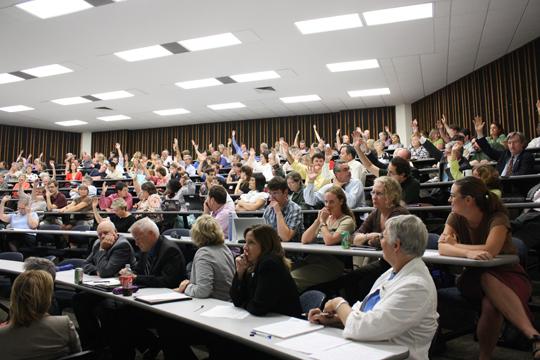General Faculty meeting yields expectation, results
September 9, 2010
NOTE FROM THE WRITER: At the end of this article as it appeared in the print edition of the Washburn Review, there was incorrect information about the outcome of a vote that took place regarding the status of the general education plan. This writer deeply regrets the errors of record that occurred.
Last Thursday, Washburn’s general faculty met for the first time in the 2010-2011 academic year. The meeting featured a plethora of different items and set the tone for the coming year.
Jerry Farley, Washburn University President, started off the meeting by speaking about the upcoming year and hitting the high points of electing a new general faculty secretary, Pat Munzer, who is chair of the allied health department.
Moving onto other issues before the faculty, Farley recognized the heads of the search committees for replacements for the two administrative positions that were vacated by the resignation of Robin Bowen and Nancy Hill midway through the spring semester of 2010.
“We have been working hard throughout the summer on the hiring process,” said Jim Martin, chair of the Vice President for Administration and Treasurer search committee. “We originally started with 30 candidates and are now focused on the three we have targeted. Hopefully the process will come to a quick conclusion soon.”
The replacement for Bowen’s job was also proceeding forward as John Mullican, chair of the Vice President for Academic Affairs search committee termed the process as, “proceeding forward with purpose.”
Finalists for both positions were scheduled to be on campus in the near future according to the committee chairs.
Farley then pivoted to the future as he spoke about one of the other central issues for Washburn: student recruitment and retention.
“We have plans underway to implement more of our strategic plan as we work to increase student retention,” said Farley.
In describing Washburn’s efforts, Farley also spoke about the school’s efforts to decrease what has been seen by the university as a growing challenge from community colleges.
“We have been working towards phasing out the presence of community colleges in Shawnee County high schools as they come into the schools to teach courses that we should offer,” said Farley. “Some of the students we offer those courses to will probably not come to Washburn but some will and we shouldn’t pass on the opportunity to grow our presence in that regard.”
Farley also spoke briefly about new enrollment rates for this year. With numbers not completely finalized, the president made mention of a double digit increase in the percent of what he termed, “straight from high school students” as well as a modest increase in transfer students.
Alluding to this point, the president also mentioned the challenges of such a growth.
“This is the first year that I can recall that we’ve had a waiting list for on campus housing,” said Farley.
After his opening remarks, Farley yielded the floor to Nancy Tate, current interim-Vice President of Academic Affairs as she read from a prepared statement outlining her expectations for the coming school year. The work ahead in changing the central mission of the university through the change to the five educational outcomes was a central point Tate spoke about.
“Today you will vote to replace the current nine general educational skills with the proposed five educational outcomes that were created based on the information obtained thru faculty workshops,” said Tate. “I’m actually excited about the new outcomes because they closely align with the outcomes outlined by the Kansas Board of Regents which will be voting on their set of outcomes at their upcoming September board meeting.”
The outcomes as outlined by Tate were what she termed, “more assessable” and will allow for increased success of Washburn students.
Tate also went on to talk about the improvement in internet technologies across the campus.
“Hopefully you will notice less dead spots throughout the campus and increase in internet traffic speed,” said Tate.
Tate also spoke about her work with Washburn Student Government Association as she urged faculty to utilize the Angel virtual classroom software to post and keep grades up to date for students to view.
Enhancing course content through utilization of a newly proposed diversity calender was another issue that Tate spoke about briefly.
The other issue of interest both to faculty and perhaps students as well was a survey that Washburn was being asked to take part in called the National Survey of Student Engagement (NSSE). The survey is a way for Washburn to gauge how well engaged students are with the university and all it has to offer students.
The results are then used as a recruiting tool for Washburn to show prospective students and their parents. Traditionally seniors have scored well compared to freshman according to Tate who termed freshman as being “clueless” to the terminology used in the survey.
After Tate finished with her statement, the meeting agenda moved to a presentation on wellness for faculty and staff by Celeste Hajek, coordinator at the Student Wellness Center.
After the wellness presentation, the old business of adopting the first portion of the new general education proposal was debated in a contentious debate in which various members of the faculty voiced concern over the piece meal nature in which the process was moving forward. With the main reservation revolving around what effect the portion under debate of the general education proposal might have on parts of the plan that might be adopted in the future.
After some speaking back and forth between opponents and proponents of the plan it was finally passed.
The meeting was adjourned shortly afterwards.



